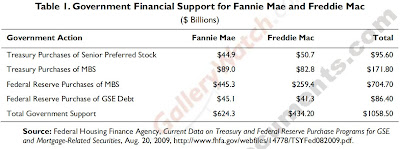 On Saturday, December 19 Senator Harry Reid released legislative language for the Patient Protection and Affordable Care Act (PPACA) as Senate Amendment 2786. These are the changes proposed by the Senate to H.R. 3592. It is expected to pass in the Senate before Christmas. Included in the amended bill is a brand new government sponsored health insurance program that provides a perfect example of how Congress creates unfunded liabilities.
On Saturday, December 19 Senator Harry Reid released legislative language for the Patient Protection and Affordable Care Act (PPACA) as Senate Amendment 2786. These are the changes proposed by the Senate to H.R. 3592. It is expected to pass in the Senate before Christmas. Included in the amended bill is a brand new government sponsored health insurance program that provides a perfect example of how Congress creates unfunded liabilities.Introduced in March of 2009 by Senator Ted Kennedy it is known as the CLASS Act (Community Living Assistance Services and Supports Act)[1] and is designed to provide insurance for long term care. This program creates a new government entitlement supported by a brand new trust fund. In the beginning there are more people paying in than taking out but as more participants vest and begin receiving benefits, payments increase and eventually swamp the income. If it sounds familiar it’s because it is very similar to the scheme that bankrupted Bernie Madoff and General Motors and it operates just like Social Security, Medicare and the entitlement programs of the State of California. Consider this, an individual pays an average premium of about $65 per month for five years (a total of $3,900) and then becomes eligible for benefits. Participants are eligible for $50 per day towards their long term care or ten times the rate at which they paid in. That is $1,500 per month as long as they are alive! For the first five years there will be no beneficiaries only premium payers. Early in the program as the beneficiaries come on line there is still positive cash flow because there are more payers than recipients but eventually beneficiaries exceed the payers, the trust fund is exhausted and the program will begin contributing to the deficit. We know this today! Yet Senator Reid would have us believe that this program will contribute $72 billion towards “paying for health care.” Here are the Congressional Budget Office (CBO) figures.

This program’s contribution to paying for health care peaks in 2015 and begins declining as payments out begin to exceed premiums in. The CBO’s scoring of Senate Amendment 2786 states, “As noted earlier, the CLASS program included in the bill would generate net receipts for the government in the initial years when total premiums would exceed total benefit payments, but it would eventually lead to net outlays when benefits exceed premiums…in the decade following 2029, the CLASS program would begin to increase budget deficits.” Zingo, a brand new unfunded liability.
This sums up the problem with government, it is accounted for like a classic Ponzi scheme[3], in other words on a cash basis. Corporations are not allowed to use this accounting method. Unlike corporations which have to bring future liabilities onto their balance sheets our government is presumed to be perpetual and simply reports cash in and cash out. If accounted for on a GAAP basis (“Generally Accepted Accounting Principles”)[4] one analysis puts the real 2008 federal budget deficit at a staggering $5.1 trillion[5], not the $455 billion reported by the Congressional Budget Office.
Now let’s look at the rest of the CBO’s scorecard on the Senate amendment.

The total cost of the program has increased 20% from the Chairman’s Mark discussed in an earlier blog[6] or $100 billion above previous estimates. So again we ask, “How does this contribute to reducing the deficit?”
The single biggest savings comes from reductions in Medicare, Medicaid, and other programs in the amount of $483 billion. They are:
- Permanent reductions in Medicare payment rates in the fee-for-service sector saving $186 billion
- Adjustments to the Medicare Advantage program saving $118 billion
- Reducing Medicaid and Medicare payments to hospitals serving large populations of low-income patients by about $43 billion
- $28 billion comes from reductions in subsidies for non-Medicare Advantage plans and changes to payment rates recommended by an Independent Payment Advisory Board established by the legislation. These recommendations are non-binding.
- CLASS (our afore mentioned Ponzi scheme) for $72 billion.
- Improvements in disbursements by adopting and regularly updating standards for electronic administrative transactions which enable electronic funds transfers saving $11 billion.
Hot off the press, the CBO today released a correction to the score it published on December 19 to wit, “Correcting that error has no impact on the estimated effects of the legislation during the 2010–2019 period. However, the correction reduces the degree to which the legislation would lower federal deficits in the decade after 2019.”[8] Oooops!
Have a Merry Christmas and caveat emptor.
_____________________________________________________
[1] http://thomas.loc.gov/cgi-bin/bdquery/z?d111:SN00697:
[2] http://www.cbo.gov/ftpdocs/108xx/doc10868/12-19-Reid_Letter_Managers.pdf
[3] http://en.wikipedia.org/wiki/Ponzi_scheme
[4] http://en.wikipedia.org/wiki/Generally_Accepted_Accounting_Principles
[5] http://www.wnd.com/index.php?fa=PAGE.view&pageId=113366
[6] https://blogger.googleusercontent.com/img/b/R29vZ2xl/AVvXsEhHBfbQYEF29qDLGEC6IH9Z_CzLM364QR6NBQXitr389IZmSnzE1ucHm3jC7joRfBX45rnMUbFWtS39GCjYTDAjxNujGKbJtKhSJNYNt9JEknVbr3Ntx7sh-Wuh8un8hUV_mHUvwKP-tYQ/s1600-h/Chairman's+Mark+chart8.jpg
[7] http://www.cbo.gov/ftpdocs/107xx/doc10732/HR3961_HonRyan.pdf
[8] http://www.cbo.gov/ftpdocs/108xx/doc10870/12-20-Reid_Letter_Managers_Correction1.pdf



















